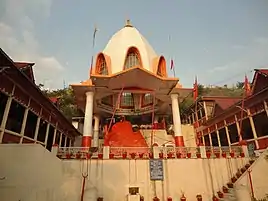Kashmiri Hindus
Kashmiri Hindus are ethnic Kashmiris who practice Hinduism and are native to the Kashmir Valley of India.[1] With respect to their contributions to Indian philosophy, Kashmiri Hindus developed the tradition of Kashmiri Saivism.[2]
| Languages | |
|---|---|
| Kashmiri, Hindi, Urdu, English | |
| Religion | |
| Hinduism | |
| Related ethnic groups | |
| Kashmiri people, Kashmiri Muslims |

History
Under the rule of Sultan Sikander Butshikan in the 14th century A.D., many Kashmiri Hindus were forcibly converted to Islam.[3][4] They began to leave the valley in much greater numbers in the 1990s during the eruption of militancy following large scale militarization of Valley.
Demography
The largest community caste of Kashmiri Hindus are the Kashmiri Pandits (Kashmiri Brahmins),[5][6] who are divided into several gotras,[7] such as the priests ("gor" or "bhasha Bhatta"), astrologers ("Zutshi"), and workers ("Karkun").[8] The majority of Kashmiris who belong to the kshatriya varna use the surname Gourtra.[9] The Wani are historically Banias, with subcastes, such as the Kesarwani.[10]
See also
- Ethnic cleansing of Kashmiri Hindus
- Kashmiri Muslim tribes from Hindu lineage
- List of Kashmiri Pandits
References
- Ling, Huping (2008). Emerging Voices: Experiences of Underrepresented Asian Americans. Rutgers University Press. p. 126. ISBN 9780813543420.
Kashmiri Muslims represent the majority population in Kashmir Valley, while Kashmiri Hindus represent a small but significant minority community.
- Snedden, Christopher (15 September 2015). Understanding Kashmir and Kashmiris. Hurst. p. 39. ISBN 9781849046220.
- Kaw, Maharaj Krishen (2001). Kashmiri Pandits. APH Publishing. pp. 25–26. ISBN 9788176482363.
Then came the fanatical and tyrannical rule of Sultan Sikander, the iconoclast (1398-1420 A.D.) who let loose a sort of hell against the non-Muslims through forced conversions and widespread destruction of their religious shrines all over the Valley. Possibly, by this time, the lower Hindu castes had got converted to Islam with the help pf passionate zeal of the Islamic missionaries moving freely among the socially backward and rigid Hindu caste hierarchies already shaken by the spread of the Buddhist creed when Kashmir was from a considerable period one of the staunchest centres of the anti-caste movement of the Buddhist cult.
- Khan, Ghulam Hassan (1973). The Kashmiri Mussulman. p. 41.
This community prior to their conversion was divided amongst the Brahmin, Kshatria, Vaish, and Shudr castes.
- Mufti, Gulzar (24 September 2013). Kashmir in Sickness and in Health. Partridge Publishing. p. 121. ISBN 9781482809985.
Hindus of the Kashmir Valley, known as Pandits, are mostly upper caste Brahmins.
- Kachru, Onkar (1998). Jammu, Kashmir, Ladakh. Atlantic Publishers. p. 75. ISBN 9788185495514.
Taking into account decennial growth rates and migration patterns, the 1981 census data suggests that there would have been 161,000 Hindus, most of them Kashmiri Pandits, in the valley in 1991.
- South Asian Language Review, Volumes 3-4. Creative Publishers. 1993. p. 64.
'Kashmiri Brahmins are said to have originally belonged to only six gotras, -By intermarriage with other Brahmins the number of gotras multiplied to 199' ( Koul 1924).
- Nagano, Yasuhiko; Ikari, Yasuke (1993). From Vedic Altar to Village Shrine: Towards an Interface Between Indology and Anthropology. National Museum of Ethnology. p. 186. Retrieved 29 September 2017.
The Hindus belong with few exceptions to the Brahman caste and are known as 'Pandits', while in other parts of India they are generally called 'Kashmiri Pandits'. These Kashmiri Brahmans are divided into three subcastes consisting, namely, of priests (gor or bhasha Bhatta), astrologers (jyotishi), and workers (karkun).
- Sehgal, Narendra (2011). Jammu & Kashmir: A State in Turbulence. Suruchi Prakashan. p. 9. ISBN 9788189622831.
- Rajghatta, Chidanand (28 August 2019). "View: Most Pakistanis are actually Indians". The Economic Times. Retrieved 22 September 2019.
The Indic influence extends across caste and clan. The last name of Burhan Wani, the slain jihadist now deified by separatists, is derived from the Hindu bania caste, and it further devolved into specific subcastes depending on what they traded in — for instance, those who trade in saffron became Kesarwani.